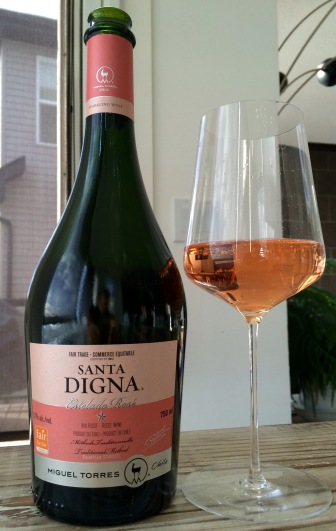[This bottle was provided as a sample for review purposes.]
Whatever your opinion is on Valentine’s Day, it has had a highly valuable (and surely unintended) side effect on the wine industry: for one lone day a year, it has shone the spotlight brightly on pink wine. Rose wines continue to be misunderstood, undervalued, unfairly derided and almost absurdly underrated, so I will happily sing the praises of any day that brings the world’s attention to them ever so briefly, even if it’s a Hallmark-created one. And if you’re going to grab a pink wine to celebrate February 14th with your true love (and after all the effort I put into the last two sentences, you’d better), I humbly suggest it should be this one, whose flavours are matched equally by its story…and its price.
Miguel Torres is one of Spain’s largest and best regarded wine empires, still entirely family-run after 5 generations. Torres brands show up in all of Spain’s top wine regions, but the family is also highly prevalent in Chile, where current CEO Miguel Torres Maczassek lived for three years starting in 2009 to head up operations. Despite being a European, international company, Torres is passionately devoted to telling a local story with each of its labels, and Torres Maczassek himself has a clear love for Chile that shows through when you talk to him and is reflected in his wines.
The most obviously interesting thing about the Estelado Rose is that it’s the world’s first sparkling rose made 100% from the Pais grape, which is highly obscure today but played a pivotal role in the development of viticulture on this side of the ocean: in fact, it could be considered the catalyst of modern winemaking in the Americas. Pais was the first vitis vinifera (the particular species of grape to which all of the world’s top quality wine-making varietals belong) grape to arrive in Chile back in the 16th century. Chile, like all New World wine countries, has no indigenous vinifera grape varietals, so all of its vinifera grapes originated as transplants from those Old World areas where varietals of this species originally grew — this is the actual meaning of the “New World”/”Old World” distinction that gets tossed around so often in wine terminology. Pais, as it turns out, has a rather productive history of being the first infiltrator to major New World wine regions: its alter-ego/close genetic relative Mission (they’re often considered the same grape but are more likely descended from a common ancestor) was the first vinifera grape to be planted in California, brought up from south of the border by Franciscan missionaries in the 18th century.
Pais is an old school vinifera grape that lacks the polish and quality pedigree of other reds in the species and is generally seen as a workhorse grape for the production of crude, bulk wines. Even so, it was Chile’s most planted grape variety from 500 years ago up until the turn of the 21st century, when it was finally unseated by Cabernet Sauvignon. The recent quality revolution in Chilean wine has been a tremendous success for the industry as a whole and its reception on the global stage, but it has been less of a positive story on those growers invested in the production of Pais, many of whom are located in areas that cannot easily support a different, higher-end and more popular varietal. A big part of Torres’ mission (no pun intended) with this wine was to bring focus, investment and quality production methods techniques to Pais, both to see what kind of inner potential it truly had and to simultaneously help support traditional local growers. The Estelado Santa Digna Brut Rose was born in 2010, is made from 100 year-old Pais vines cultivated by longstanding grower families and proudly displays a Fair Trade sticker on its label: “a reward for the land and its people”, as Torres Chile puts it.
This is a traditional method sparkling wine, which means that it was made in the same way as Champagne, with the second fermentation that infuses the wine with its bubbles taking place inside the very bottle that you end up taking home from the wine shop. I’ll avoid getting into the specific details of the process and its alternatives, but suffice to say that it’s a more laborious, hands-on, artisanal, time-intensive method to create a sparkling wine that results in a more complex and harmonious final product, with smaller, more integrated and more persistent bubbles and a wider variety of distinctive flavours. All of this usually translates to a bigger price tag — I defy you to find a half-decent rose Champagne for less than $50 — but this bottle clocks in at under $25, a miracle in and of itself. And, as is usually the case with wine, the attention to detail shown in production carries through in the glass.
The Estelado is a gorgeous vivid salmon colour but is more layered and restrained on the nose than its potent hue would lead you to believe: parchment paper, chalk and “swimming pool” (chlorine, wet air, minerals) aromas are interwoven with the more primary notes of pink lemonade, cranberry and grapefruit, keeping the fruit more on the edges of the senses and less at the forefront. It’s the same story on the palate, a delicate blend of anise, pink peppercorn, rose petals and dried strawberry, with a biscuity/yeasty note and a texture that is first creamy, then precise as scouring acid rides the wave of bubbles and leaves your mouth feeling clean and invigorated after each sip. This would be great with sushi or fish and chips, as it echoes the slightly fermented notes of the former and would slice through any oily heaviness of the latter.
This is an ingenious way to reinvigorate a bygone grape with an image problem and reconnect a wine nation with its history. While Pais will likely never produce a wine as robust and polished as a good Chilean Cab, its use in a sparkling rose allows it to lend its unique voice to the wine without having to grapple with Big Modern Red expectations. Everybody wins: the growers, the brand, the country, and at the Estelado’s price tag, the consumer.
89+ points
$20 to $25 CDN





Where can I find Santa Digna Estelado Rose in Calgary?
LikeLike
Hi Pamela,
Great question! It looks to be fairly widely available – go to http://www.liquorconnect.com and enter it into the product search window, which will allow you to access locations in Calgary that have recently had it for sale. Among other spots, Willow Park is likely a safe bet. Good luck!
LikeLike